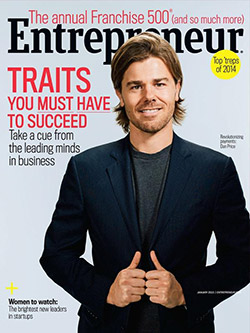
It’s 2015. The arrival of any new year inevitably provokes discussion on how the next 12 months will unfold, but with the pace of innovation accelerating faster than ever before, progressive entrepreneurs should be looking even further ahead and adapting their businesses for a new decade.
The period between 2015 and 2020 is poised to redefine virtually every facet of how we live and work. It probably won’t bring jetpacks and hoverboards, but it will usher in other radical technologies, business models, customer experiences and even a new breed of entrepreneurs—a wave of so-called digital natives who think and act differently from every generation before them.
Entrepreneur asked leading futurists and cultural anthropologists what this brave new world will be like, how it will evolve and what you need to know to thrive within it. In short: how to play chess while everyone else is playing checkers. Here are their forecasts, in their own words.
The panel
Tom Cheesewright founded the applied futurism practice Book of the Future and is a regular presence on U.K. TV and radio. He previously launched a series of technology-driven startups, including venture-backed big data analytics firm CANDDi.
Peter Diamandis is chairman and CEO of the XPrize innovation competition, executive chairman of Silicon Valley-based teaching organization Singularity University and the founder of more than a dozen high-tech organizations.
Steven Kotler co-founded and serves as director of research for the Flow Genome Project. Diamandis and Kotler have teamed on two books: Abundance: The Future Is Better Than You Think and Bold: How to Go Big, Create Wealth and Impact the World.
Bob Johansen is a distinguished fellow at nonprofit research organization Institute for the Future. His latest book, The Reciprocity Advantage: A New Way to Partner for Innovation and Growth (written with Karl Ronn), argues that businesses can gain a competitive advantage by sharing assets and forming collaborative relationships.
Brian Solis is a principal
analyst at research and advisory firm Altimeter Group whose work examines disruptive technology’s impact on business and society. His latest book is What’s the Future of Business? Changing the Way Businesses Create Experiences.
The future of …SCALING AND STRATEGY
Johansen: Business is moving from products to services to experiences. If you think about the next five years, it’s going to get harder and harder to make money in transactional businesses, so you’ve got to figure out some way to break out of that. The future of small business is more and more about mutual-benefit partnering on a global scale, which we call “the reciprocity advantage.” It involves finding your right-of-way—the space where you can innovate; finding a partner to help you do the things you can’t do alone; experimenting to learn; and then scaling.
Diamandis: Over the next five years, we’ll go from 2.5 billion people online to upward of
5 billion to 7 billion online. These people represent a long tail of the economy, and there are going to be billion-dollar companies serving people across the developing world on a micro-payment level: a penny here, 10 cents there. As we bring these 3 billion to 5 billion new minds online, these individuals are now able to become entrepreneurs themselves, and the tools they can access are extraordinary.
The best way to become a billionaire is to help a billion people. Identify a product or service that can impact a billion people, begin with a near-term revenue stream and grow it using scalable, exponential technologies, gamification, crowd and community—all the tools that enable you to take big swings at the problem without having to scale a huge number of people. If you’re passionate about solving a problem, you literally can be a guy or gal in a garage using the internet and exponential tools and technologies to take on any problem at scale. An individual has the potential to impact the lives of a billion people in a decade.
Kotler: There are also exponential organizational tools, like crowdsourcing, crowdfunding and online communities. [An] extremely personalized coffee shop in a tiny town can have a global reach in ways it couldn’t before, and if it wants to suddenly morph up to a giant chain, it will have access to crowdsourcing, crowdfunding and all the stuff it needs to scale up very, very quickly.
Johansen: Cloud-served supercomputing … will disrupt the concept of scaling. Computing will increasingly occur on the network, and that means the ability to scale—to amplify—will be dramatically better than anything we’ve had before. It’s going to get easier and easier to create businesses. It used to be that startups had to buy a server or get server time somehow, but now you get it off the cloud, and if you have an idea in the morning, you can start a company in the afternoon.
The future of GENERATIONAL RELATIONS
Solis: The older generation is making decisions based on their experience and how they went through life—going to college, getting a job, getting married, buying a house and buying a car. Today’s generation is rethinking whether or not college is important, and whether they want full-time jobs or want to be entrepreneurs. They’re rethinking whether to buy cars because they can take Uber everywhere. They’re shedding belongings because they don’t want the burdens of ownership. Their value system is profoundly different, and they’re forming relationships with products and services based on the things they value and appreciate. They want authenticity, they want transparency, and they want to know your business is thinking about questions like sustainability.
Johansen: Digital natives—people who are now 18 or younger—are the first generation becoming adults in the age of early-stage social media, early-stage cloud-served supercomputing and quite advanced video-gaming interfaces that are many times better than what we have in offices. The digital natives are a very disruptive force. They’re very entrepreneurial and tend to have a lot of global connectivity. They’re very interested in environmental issues and sustainability. They’re the ones to watch out for.
Another future force [is what] we call “socialstructing,” which is network-based organizational structures. It’s remarkable how people can form socialstructed organizations, and they can be very disruptive in positive ways and negative ways. The big socialstructed threat now is ISIS, which has a very old theology and a cutting-edge set of digital skills.
Cheesewright: I recently got involved in an exercise looking at the future of education. We spoke to a lot of employers, and they all came back with some version of what I ended up calling “the three C’s”—the skills they want from young employees. They want them to be able to curate, and discover and qualify information; they want them to be able to create, and synthesize something new from the information they’ve discovered; and they want them to communicate, to
sell their ideas to their colleagues and customers. They don’t care about the knowledge in young employees’ heads—to employers, knowledge is just the context in which the skills are taught.
The future of COLLABORATIVE BUSINESS
Johansen: Physical stores like hardware stores or coffee shops are going to get increasingly commoditized. You already see people coming into physical stores with smartphones and doing price comparisons. That means you have to figure out how to offer something they can’t get online. It’s a world of “and”—it’s not either in-store shopping or online shopping, it’s blended-reality shopping. The value is going to come from services, and the way of delivering the value is going to come from mutual-benefit partnering. Ask yourself, How can I partner with somebody to allow me to do something I couldn’t do alone?
Cheesewright: Maybe a mom-and-pop shop has a really good local delivery service that currently only serves its own products and clientele, but could serve others. Maybe they’ve got really good business administration—is that a service they could open to others? Maybe they’ve got a storefront—can they open up space to other retailers who can’t afford the rent on their own? Breaking open your business and thinking about each different component of value and whether it can be interfaced with and offered to other parties is a really interesting model for agility moving forward.
The future of TECHNOLOGY
Kotler: It’s not just the tech that’s changing. The interfaces are becoming incredibly user-friendly, and when it comes to something like 3-D printing systems, it’s plug-and-play—if you can point a mouse and click, you can print objects.
The scale of what is possible is also changing considerably. When digital technologies first started to come up, what got democratized was information sharing: “Here’s a song; you can have it for free.” But 3-D printing can democratize the entire manufacturing industry.
Diamandis: We’re also going to see a real explosion in sensor technology. Sensors are becoming extraordinarily cheap, ubiquitous and accessible, and it’s going to lead to a real revolution in data and data mining, especially in healthcare and biomedicine. We’re going to see robots entering the workspace, and we’re going to see an explosion in drone applications, with entrepreneurs utilizing them for data gathering and for services.
Another meta-trend I see is extreme personalization, where data is about what I want, when I want it and where I want it, and consequently, service providers that can provide that to me. I’ll constantly be sensed for my biomedical chemistries—I walk into a restaurant and I’m being fed the amount of calories and the vitamins I need to consume that day. Or I’m at home 3-D printing the foods I need that day.
Every business will incorporate these new technologies. You’ll have coffee shops taking Bitcoin, or coffee shops that have big data knowledge of customers—as they walk in, the drink is being prepped, because they know that every day, Steven Kotler orders the same thing. There should never be a coffee shop out of banana bread at 10 a.m., because they know exactly what their usage patterns are on that day.
All companies are going to use these technologies to be as efficient as possible. Their job is to layer on top of that culture, comfort and familiarity—the human aspects of a fun place to go.
The future of THE CUSTOMER EXPERIENCE
Solis: The way we go about business is slowly dying. Connected consumerism says that things are not only changing, but are so radically different that the business models we have today cannot support a much more dynamic approach to the market. Even if you’re over the age of 35, if you use an iPad or social networks or apps, you slowly start to act like a Millennial. It influences how you make decisions and where you go for information. All of this starts to add up differently from being a traditional customer: The touchpoints, the screens we use, our expectations—we become more demanding, more informed and more connected.
Johansen: [Another] force is gameful engagement. It’s not just gamifying, but changing the nature of work to add a playful and engaging element. It’s how you engage with people on their terms—not just pushing product at them, but something like the Doritos “Crash the Super Bowl” contest, which gives anybody the chance to do a commercial that Doritos will show during the Super Bowl. It’s the future of marketing and advertising, and the digital
natives are going to require it.
Solis: The research you do around the digital customer experience allows you to understand where you’re going to make your investments. A lot of times, people go to market believing that the functions of sales and marketing and services are just the bolt-on pieces to go and be successful around your vision and your product, when in fact, it’s the opposite.
The future of THE ENTREPRENEURIAL VISION
Solis: Ideas don’t really count until you can demonstrate relevance, engagement and momentum. Entrepreneurs who have a purpose will succeed, as opposed to entrepreneurs who have a product. If you don’t understand this, you’re
destined to be irrelevant because you never tried to be relevant in the first place.
Cheesewright: If you give a kid a die-cast toy car for Christmas, chances are it won’t last a month as a favorite toy. But if you give him a box of Lego bricks, he’s probably going to get two, three, four, five or 10 years of use [out of them]. That’s because no matter what instructions are on the back of the Lego package or what picture is on the front, it can be adapted to be something else.
Historically, business has focused heavily on optimization: We tried to make every business as efficient as it could be at what it did. But I would argue that today it’s more important to change than it is to optimize, because the rate of change around us is accelerating. The better you become at one thing, the deeper into your rut you go, and the harder it is to get out of that rut when change comes.
Johansen: The future of small business is very bright, because you’ve got this potential to create new business models and partner with very small or very large organizations, and then to scale much more quickly than before. This is entrepreneurial heaven we’re approaching here. If you’ve got a great idea and the ability to pull together a company, there’s no better time in history to do it.
[“source-Entrepreneur”]










